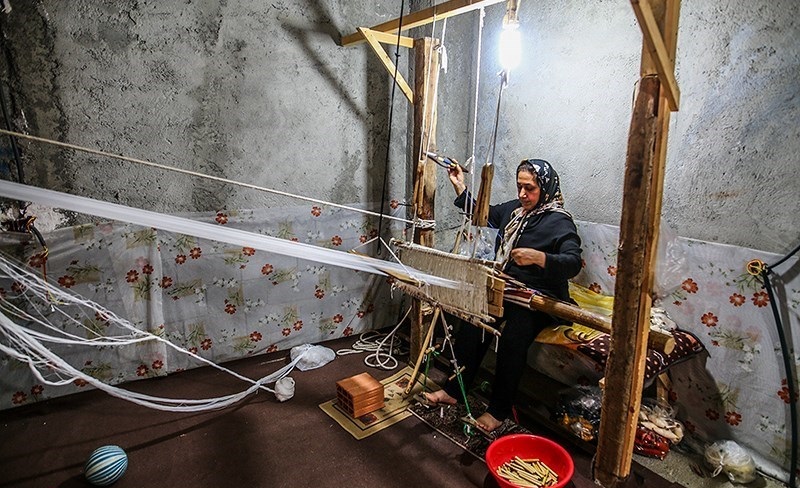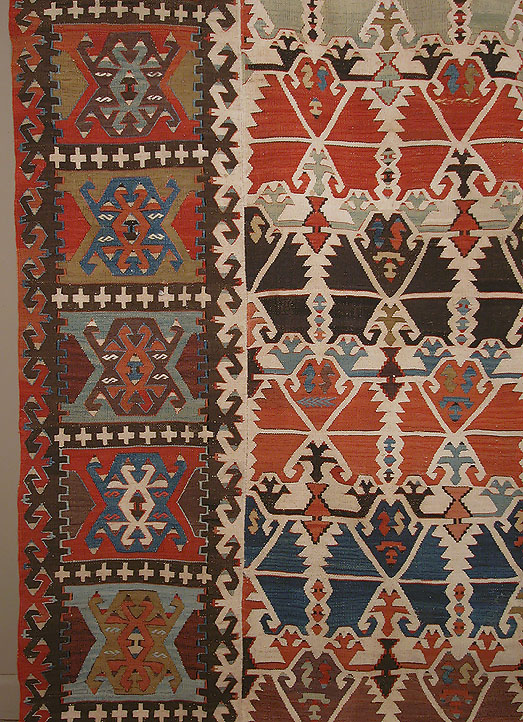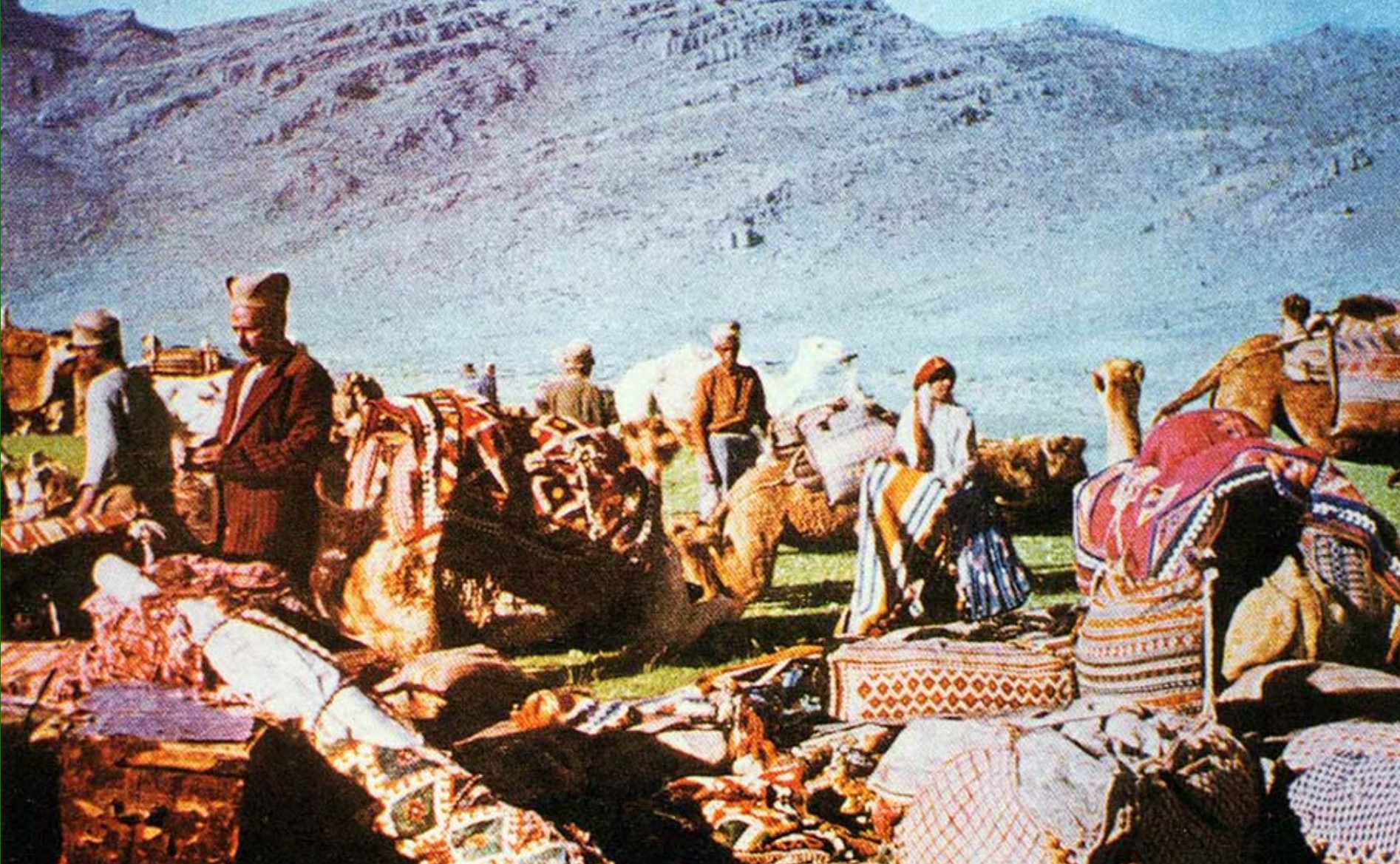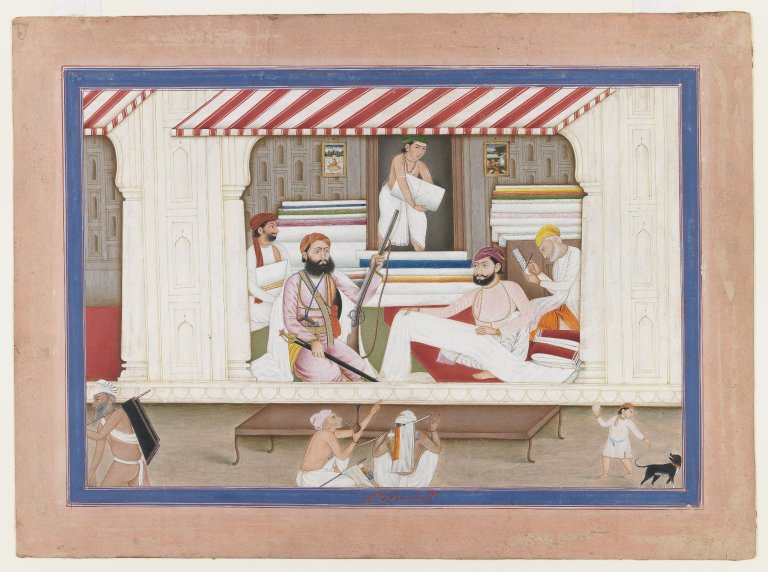|
Jajim
Jajim (; ; ; ) also spelled as gelims, or Jajim-bafi, is a handmade, flat-woven textile made of colored natural fiber which is created and used in the majority of villages and rural areas of Iran. Other locations the Jajim is found include Azerbaijan, Turkey, and India. About The nomadic Shahsevan people are thought to be the originators of the handicraft. Jajim is a thicker textile, similar to a blanket. The yarn used to created Jajim are either wool, cotton, or a wool and cotton-blend. In contrast to the classically woven kilims and carpets which is a single panel, to weave a Jajim you create multiple narrow woven panels (often 4) and the panels are sewn together. They traditionally were used as way for nomadic people to pack their belongings for migration. They have also been used as a mattress, to wrap a bed, as a korsi cover (a table heater), as a curtain, as a tent, and as a carpet. After a Qashqai bride and groom are married, they use Jajim to create a ceremonial tent. ... [...More Info...] [...Related Items...] OR: [Wikipedia] [Google] [Baidu] |
Jajim Bafi In Iran 2
Jajim (; ; ; ) also spelled as gelims, or Jajim-bafi, is a handmade, flat-woven textile made of colored natural fiber which is created and used in the majority of villages and rural areas of Iran. Other locations the Jajim is found include Azerbaijan, Turkey, and India. About The nomadic Shahsevan people are thought to be the originators of the handicraft. Jajim is a thicker textile, similar to a blanket. The yarn used to created Jajim are either wool, cotton, or a wool and cotton-blend. In contrast to the classically woven kilims and carpets which is a single panel, to weave a Jajim you create multiple narrow woven panels (often 4) and the panels are sewn together. They traditionally were used as way for nomadic people to pack their belongings for migration. They have also been used as a mattress, to wrap a bed, as a korsi cover (a table heater), as a curtain, as a tent, and as a carpet. After a Qashqai bride and groom are married, they use Jajim to create a ceremonial tent. ... [...More Info...] [...Related Items...] OR: [Wikipedia] [Google] [Baidu] |
Korsi
A ''korsi'' or ''korsí,'' or sandali (Persian: کرسی) is a type of low table found in Iran and Afghanistan, with a heater underneath it, and blankets thrown over it. It is a traditional item of furniture in Iranian culture. A family or other gathering sits on the floor around the ''korsi'' during the winter. A ''korsi'' used to be quite popular for entire families to gather together during yearly '' Yaldā'' celebrations. ''Korsis'' are generally heated with electric elements or, traditionally, with a brazier containing hot coals that is placed under the table. The table is covered with a thick cloth overhanging on all sides to keep its occupants warm. The occupants sit on large cushions around the ''korsi'' with the cloth over their laps. A special woven rug called ''ru korsi'' (Persian: روکرسی), is usually placed over any blankets to protect them from food stains. Jajim textiles are sometimes used as the blankets for a korsi. See also * Kotatsu, a similar Japanese ... [...More Info...] [...Related Items...] OR: [Wikipedia] [Google] [Baidu] |
Kilim
A kilim ( az, Kilim کیلیم; tr, Kilim; tm, Kilim; fa, گلیم ''Gilīm'') is a flat tapestry-woven carpet or rug traditionally produced in countries of the former Persian Empire, including Iran, the Balkans and the Turkic countries. Kilims can be purely decorative or can function as prayer rugs. Modern kilims are popular floor coverings in Western households. Etymology The term 'kilim' originates from the Persian ''galīm'' (گلیم) where it means 'to spread roughly', perhaps of Akkadian or Aramean origin. another name for Galim(Gilim) is Plas, Ferdowsi and other persian poet mentioned both Galim and plas as synonyms in Shahnameh No 35 mentioned as Plas(pluNo14 mentioned as Gali History Like Pile weave, pile carpets, kilim have been produced since ancient times. The explorer Mark Aurel Stein found kilims dating to at least the fourth or fifth century CE in Hotan, China: :"As kilims are much less durable than rugs that have a pile to protect the warp and weft, it is ... [...More Info...] [...Related Items...] OR: [Wikipedia] [Google] [Baidu] |
Persian Handicrafts
Iranian handicrafts are handicraft or handmade crafted works originating from Iran. Basketry and wickerwork * , a bamboo wickerwork or textile, used to make floor mats, stools, and fans. * , a palm leaf basketry. * , an indigenous boat made of tobacco leaves found in the Hamun Lake region Carpets and rugs * Persian carpet ** Abadeh rug, type of carpet with a large diamond pattern ** Afshar rugs, carpets from the Turkic Afshar tribe ** Ardabil Carpet, the name of two different famous Safavid carpets which became a style ** Dilmaghani, the oldest existing manufacturers of hand knotted carpets ** Gabbeh, a type of Persian nomadic carpet ** Heriz rug, type of carpet with copper in the wool and bold patterns with a large medallion ** Shiraz rug, a type of Persian carpet ** Tabriz rug, genre of carpets found in Tabriz * Kilims, flat woven rug or tapestry ** , type of Kilim * Soumak, flat woven rug, bedding, or tapestry; a stronger and thicker weave than a Kilim File:Ardabil Carpet ... [...More Info...] [...Related Items...] OR: [Wikipedia] [Google] [Baidu] |
Iranian Handicrafts
Iranian handicrafts are handicraft or handmade crafted works originating from Iran. Basketry and wickerwork * , a bamboo wickerwork or textile, used to make floor mats, stools, and fans. * , a palm leaf basketry. * , an indigenous boat made of tobacco leaves found in the Hamun Lake region Carpets and rugs * Persian carpet ** Abadeh rug, type of carpet with a large diamond pattern ** Afshar rugs, carpets from the Turkic Afshar tribe ** Ardabil Carpet, the name of two different famous Safavid carpets which became a style ** Dilmaghani, the oldest existing manufacturers of hand knotted carpets ** Gabbeh, a type of Persian nomadic carpet ** Heriz rug, type of carpet with copper in the wool and bold patterns with a large medallion ** Shiraz rug, a type of Persian carpet ** Tabriz rug, genre of carpets found in Tabriz * Kilims, flat woven rug or tapestry ** , type of Kilim * Soumak, flat woven rug, bedding, or tapestry; a stronger and thicker weave than a Kilim File:Ardabil Carpet ... [...More Info...] [...Related Items...] OR: [Wikipedia] [Google] [Baidu] |
Qashqai People
Qashqai people (pronounced ; fa, قشقایی) are a tribal confederation in Iran mostly of Turkic origin. They are also believed to have incorporated Lurs, Kurds, and Arabs. Almost all of them speak a Western Turkic (Oghuz) language known as the Qashqai language, which they call "Turki", as well as Persian (the national language of Iran) in formal use. The Qashqai mainly live in the provinces of Fars, Khuzestan, Kohgiluyeh and Boyer-Ahmad, Chaharmahal and Bakhtiari, Bushehr and Southern Isfahan, especially around the cities of Shiraz and Firuzabad in Fars. The majority of Qashqai people were originally nomadic pastoralists and some remain so today. The traditional nomadic Qashqai traveled with their flocks twice yearly between the summer highland pastures north of Shiraz roughly 480 km or 300 miles south and the winter pastures on lower (and warmer) lands near the Persian Gulf, to the southwest of Shiraz. The majority, however, have now become partially or wholly s ... [...More Info...] [...Related Items...] OR: [Wikipedia] [Google] [Baidu] |
Textile Arts Of India
Textile is an Hyponymy and hypernymy, umbrella term that includes various Fiber, fiber-based materials, including fibers, yarns, Staple (textiles)#Filament fiber, filaments, Thread (yarn), threads, different #Fabric, fabric types, etc. At first, the word "textiles" only referred to woven fabrics. However, weaving is not the only manufacturing method, and many other methods were later developed to form textile structures based on their intended use. Knitting and Nonwoven, non-woven are other popular types of fabric manufacturing. In the contemporary world, textiles satisfy the material needs for versatile applications, from simple daily clothing to Bulletproof vest, bulletproof jackets, spacesuits, and Medical gown, doctor's gowns. Textiles are divided into two groups: Domestic purposes [consumer textiles] and technical textiles. In consumer textiles, Aesthetics (textile), aesthetics and Textile performance#Comfort, comfort are the most important factors, but in technical tex ... [...More Info...] [...Related Items...] OR: [Wikipedia] [Google] [Baidu] |
Textile Arts Of Azerbaijan
Textile is an umbrella term that includes various fiber-based materials, including fibers, yarns, filaments, threads, different fabric types, etc. At first, the word "textiles" only referred to woven fabrics. However, weaving is not the only manufacturing method, and many other methods were later developed to form textile structures based on their intended use. Knitting and non-woven are other popular types of fabric manufacturing. In the contemporary world, textiles satisfy the material needs for versatile applications, from simple daily clothing to bulletproof jackets, spacesuits, and doctor's gowns. Textiles are divided into two groups: Domestic purposes onsumer textilesand technical textiles. In consumer textiles, aesthetics and comfort are the most important factors, but in technical textiles, functional properties are the priority. Geotextiles, industrial textiles, medical textiles, and many other areas are examples of technical textiles, whereas clothing and ... [...More Info...] [...Related Items...] OR: [Wikipedia] [Google] [Baidu] |
Textile Arts Of Turkey
Textile is an umbrella term that includes various fiber-based materials, including fibers, yarns, filaments, threads, different fabric types, etc. At first, the word "textiles" only referred to woven fabrics. However, weaving is not the only manufacturing method, and many other methods were later developed to form textile structures based on their intended use. Knitting and non-woven are other popular types of fabric manufacturing. In the contemporary world, textiles satisfy the material needs for versatile applications, from simple daily clothing to bulletproof jackets, spacesuits, and doctor's gowns. Textiles are divided into two groups: Domestic purposes onsumer textilesand technical textiles. In consumer textiles, aesthetics and comfort are the most important factors, but in technical textiles, functional properties are the priority. Geotextiles, industrial textiles, medical textiles, and many other areas are examples of technical textiles, whereas clothing and ... [...More Info...] [...Related Items...] OR: [Wikipedia] [Google] [Baidu] |
Textile Arts Of Iran
Textile is an umbrella term that includes various fiber-based materials, including fibers, yarns, filaments, threads, different fabric types, etc. At first, the word "textiles" only referred to woven fabrics. However, weaving is not the only manufacturing method, and many other methods were later developed to form textile structures based on their intended use. Knitting and non-woven are other popular types of fabric manufacturing. In the contemporary world, textiles satisfy the material needs for versatile applications, from simple daily clothing to bulletproof jackets, spacesuits, and doctor's gowns. Textiles are divided into two groups: Domestic purposes onsumer textilesand technical textiles. In consumer textiles, aesthetics and comfort are the most important factors, but in technical textiles, functional properties are the priority. Geotextiles, industrial textiles, medical textiles, and many other areas are examples of technical textiles, whereas clothing and ... [...More Info...] [...Related Items...] OR: [Wikipedia] [Google] [Baidu] |
Oriental Rugs And Carpets
The Orient is a term for the East in relation to Europe, traditionally comprising anything belonging to the Eastern world. It is the antonym of ''Occident'', the Western World. In English, it is largely a metonym for, and coterminous with, the continent of Asia, loosely classified into the Western Asia, Southeast Asia, South Asia, Central Asia, East Asia, and sometimes including the Caucasus. Originally, the term ''Orient'' was used to designate only the Near East, and later its meaning evolved and expanded, designating also the Middle East, Central Asia, South Asia, Southeast Asia, or the Far East. The term ''oriental'' is often used to describe objects from the Orient; however in the United States it is considered an outdated and often offensive term by some, especially when used to refer to people of East Asian and Southeast Asian descent. Etymology The term "Orient" derives from the Latin word ''oriens'' meaning "east" (lit. "rising" < ''orior'' " rise"). The use of the w ... [...More Info...] [...Related Items...] OR: [Wikipedia] [Google] [Baidu] |
Tapestries
Tapestry is a form of textile art, traditionally woven by hand on a loom. Tapestry is weft-faced weaving, in which all the warp threads are hidden in the completed work, unlike most woven textiles, where both the warp and the weft threads may be visible. In tapestry weaving, weft yarns are typically discontinuous; the artisan interlaces each coloured weft back and forth in its own small pattern area. It is a plain weft-faced weave having weft threads of different colours worked over portions of the warp to form the design. Tapestry is relatively fragile, and difficult to make, so most historical pieces are intended to hang vertically on a wall (or sometimes in tents), or sometimes horizontally over a piece of furniture such as a table or bed. Some periods made smaller pieces, often long and narrow and used as borders for other textiles. European tapestries are normally made to be seen only from one side, and often have a plain lining added on the back. However, other traditi ... [...More Info...] [...Related Items...] OR: [Wikipedia] [Google] [Baidu] |








